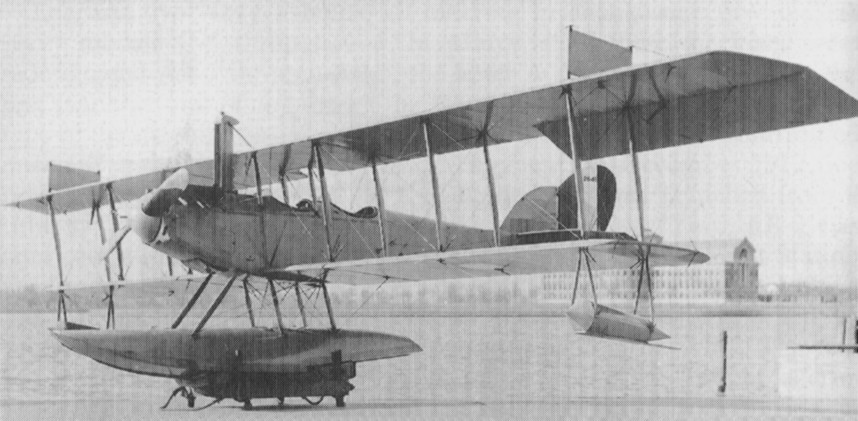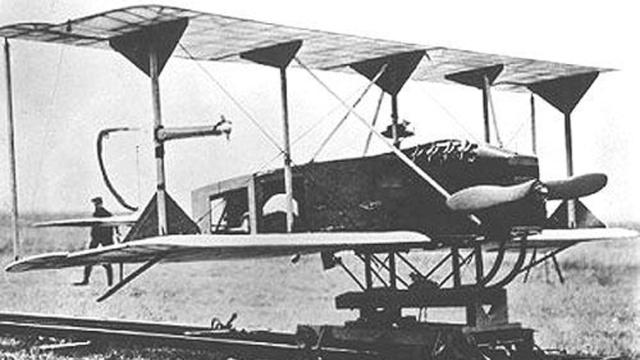In 1915, nearly two decades after patenting the world’s first radio-controlled boat, famed Serbian-America inventor Nicola Tesla imagined fleets of unmanned aerial combat vehicles being sent to war instead of pilots. Little did he know, the US Navy was already hard at work on that very same vision.
Between 1898, when Tesla first demonstrated remote control via radio waves, and 1914, the start of World War I, inventors around the world tinkered with Tesla’s revolutionary idea. One such man was American inventor Elmer Sperry, a naval gyroscope maker in Lake Success, New York. See, hitting another ship with naval artillery in the open ocean is really tough on account of the rolling seas constantly throwing the gun barrels out of aim. Sperry’s gyroscopes auto-corrected and balanced the these naval guns, essentially cancelling out the rolling of the waves. And if the gyroscopes could do that for boats, Sperry realised in 1911, they could do the same for remotely operated aircraft.
He took his proposal to the Naval Consulting Board, who approved $US50,000 in research funding and in 1913 provided a “flying boat” — a fixed wing aircraft with a hull for water landings instead of landing gear — to test the gyro system. By 1916, Sperry and his son Lawrence, who also worked as an engineer on the project, teamed up with Peter Hewitt, an early R/C developer, to further develop the radio control mechanisms. Together, they developed an early autopilot system that would allow for a plane to be launched from a naval ship, fly a predetermined course before either dropping a load of bombs or suicide diving its target.

The plane’s autopilot suite consisted of Sperry’s adapted gyroscopic stabiliser, a directive gyroscope, an aneroid barometer for maintaining altitude, servo-motors to control the steering mechanisms, and a distance gearing device that measured how far the plane traveled based on the number of engine revolutions. When the distance gear hit a preset limit, the flying bomb would (or at least should) have dived back to earth.
The first iteration of the Sperry Hewitt-Sperry Automatic Aeroplane system flew successfully in September 1917. An on-board backup pilot handled the takeoff and landing while the plane’s autopilot took care of the in-flight aviation. By November that year, the plane’s distance gearing had been refined enough to drop test bombs (rather than dive) within 3km of its intended target. With these early successes, the US Senate approved the design and ordered the Navy to provide seven Curtiss N-9 seaplanes as well as purchase six of Sperry’s automatic control units for further development. The Navy pumped another $US200,000 into the project and set up a research centre in Copiague, Long Island.
Unfortunately, the Curtiss N-9 quickly proved to be an unsuitable platform for the project and a series of specially-built Curtiss aircraft were ordered instead. These aircraft, combined with Sperry’s gyroscopic stabilisers and Hewitt’s radio control mechanisms would become the Sperry-Hewitt Flying Bomb, an explosive-laden pilot-less aircraft (aka an aerial torpedo or flying bomb) and precursor to the modern cruise missile.
Measuring 4.5m long with a 8m wingspan, the 680kg auto-plane could hit 145km/h (just slightly slower than the roughly 200km/h average top speed of manned bi-planes of the era) thanks to its 100 HP Curtiss OX-5 piston engine, and reach more than 80km/h while toting a thousand pounds of explosive. Designed as a dedicated UAV, the planes did not include seats or conventional pilot controls. And, being the middle of WWI, these flying bombs underwent precisely zero flight or wind-tunnel testing before being produced, an oversight that would almost immediately be regretted.
Just getting the flying bombs into the air proved nearly impossible. Unlike the catapult-launched N-9 seaplanes, Hewitt and Sperry first attempted to launch the flying bombs by sliding them down a long wire. Three wrecked flying bombs later, the team switched back to a conventional catapult, which scooted them down a 45m track using a three-tonne weight as a fulcrum. This was barely better. The next two flying bombs, launched in early 1918, got into the air but were too tail heavy, stalled immediately and crashed.
After destroying five of their precious prototypes, Sperry and Hewitt went about redesigning the airframe so that it could, you know, actually fly. Sperry’s assistant, N. W. Dalton, was able to get his hands on a newfangled Marmon automobile, so the team strapped the Flying Bomb to the car’s roof and sped down the Long Island Motor Parkway at 80 mph to calibrate and optimise the flight controls.

The Marmon proved to be a promising launch platform as well. In March of 1918 the Flying bomb successfully lifted off from the vehicle’s roof and flew a controlled path of more than 1000 yards, making it the first heavier-than-air UAV to ever take flight. It would also be the only time the Flying Bomb actually flew. Subsequent car-based launches were unsuccessful, even after the vehicle was outfitted with rail wheels and driven along the Long Island Rail Road to reduce pre-launch turbulence. And, after that, further catapult-based platforms and the addition of extra gyro stabilisers proved ineffective too. Every time, the plane would take off and then immediately crash. By September of 1918, Sperry and Hewitt had to abandon the Flying Bomb design because they had crashed all of their prototypes, and nobody on the team thought that they were air-worthy anyway.
For the remaining duration of the War, Sperry and Hewitt focused their attention on the N-9 platform, with a small degree of success. Using a new catapult design, the team successfully launched an unmanned N-9. It flew closely to its intended flight path but was lost at sea when its distance gearing failed to bring down the plane after 13km. The plane was last seen above Bayshore Air Station before disappearing into the Atlantic.
When World War I came to an end in November of 1918, Sperry and Hewitt had notched fewer than 100 successful N-9 flights and just one (debatably) successful Flying Bomb launch. But they had proven that the concept of unmanned aerial combat was at least plausible. The Navy subsequently took control of the program from Sperry, though it would be nearly a century before anybody figured out how to land a UAV at sea. [Wikipedia – Designation Systems – Mentor – Defence News – Unmanned Vehicles UK – Aviation Knowledge]
